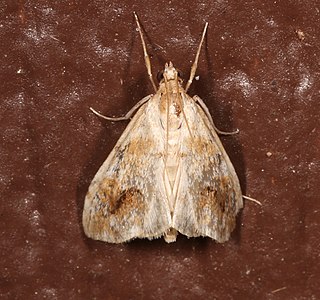Chlorobaptella is a monotypic moth genus of the family Crambidae erected by Eugene G. Munroe in 1995. Its only species, Chlorobaptella rufistrigalis, was first described by William Barnes and James Halliday McDunnough in 1914. It is found in North America, where it has been recorded from California and Nevada. Moths in this genus are distinguished from moths in similar genera by their small palpi and obsolete tongues.

Hellula is a genus of moths of the family Crambidae. It was described by Achille Guenée in 1854
Mojavia is a monotypic moth genus of the family Crambidae erected by Eugene G. Munroe in 1961. It contains only one species, Mojavia achemonalis, which was first described by William Barnes and James Halliday McDunnough in 1914. It is found in North America, where it has been recorded from Arizona, California, Nevada, New Mexico and Texas.
Diptychophora harlequinalis is a moth in the family Crambidae. It was described by William Barnes and James Halliday McDunnough in 1914. It is found in North America, where it has been recorded from Arizona.
Microcausta bipunctalis is a moth in the family Crambidae. It was described by William Barnes and James Halliday McDunnough in 1914. It is found in North America, where it has been recorded from Arizona.
Evergestis eurekalis is a moth in the family Crambidae. It was described by William Barnes and James Halliday McDunnough in 1914. It is found in North America, where it has been recorded from Arizona, California and Utah.

Evergestis lunulalis is a moth in the family Crambidae. It was described by William Barnes and James Halliday McDunnough in 1914. It is found in North America, where it has been recorded from Arizona, New Mexico and Texas.
Evergestis triangulalis is a moth in the family Crambidae. It was described by William Barnes and James Halliday McDunnough in 1914. It is found in North America, where it has been recorded from Arizona, Nevada and New Mexico.
Evergestis vinctalis is a moth in the family Crambidae. It was described by William Barnes and James Halliday McDunnough in 1914. It is found in North America, where it has been recorded from Alberta, Arizona, British Columbia, California, Colorado, Kansas, Montana, Nevada, New Mexico, Texas and Wyoming.
Orenaia alticolalis is a moth in the family Crambidae. It was described by William Barnes and James Halliday McDunnough in 1914. It is found in North America, where it has been recorded from Alberta and Colorado.
Orenaia trivialis is a moth in the family Crambidae. It was described by William Barnes and James Halliday McDunnough in 1914. It is found in North America, where it has been recorded from Colorado and the Yukon Territory.
Loxostege quaestoralis is a moth in the family Crambidae. It was described by William Barnes and James Halliday McDunnough in 1914. It is found in North America, where it has been recorded from California to New Mexico.
Loxostege typhonalis is a moth in the family Crambidae. It was described by William Barnes and James Halliday McDunnough in 1914. It is found in North America, where it has been recorded from Arizona and New Mexico.
Pseudopyrausta santatalis is a moth in the family Crambidae. It was described by William Barnes and James Halliday McDunnough in 1914. It is found in the United States, where it has been recorded from southern Texas and Florida. It is also found in the West Indies and Mexico.
Frechinia lutosalis is a moth in the family Crambidae. It was described by William Barnes and James Halliday McDunnough in 1914. It is found in North America, where it has been recorded from Arizona, Colorado and New Mexico.
Apilocrocis brumalis is a moth in the family Crambidae. It was described by William Barnes and James Halliday McDunnough in 1914. It is found in Mexico and the southern United States, where it has been recorded from southern Texas.
Blepharomastix potentalis is a species of moth in the family Crambidae first described by William Barnes and James Halliday McDunnough in 1914. It is found in North America, where it has been recorded from Arizona.
Blepharomastix pseudoranalis is a species of moth in the family Crambidae first described by William Barnes and James Halliday McDunnough in 1914. It is found in North America, where it has been recorded from Arizona.
Desmia desmialis is a moth in the family Crambidae. It was described by William Barnes and James Halliday McDunnough in 1914. It is found in North America, where it has been recorded from Arizona.
Mecyna luscitialis is a moth in the family Crambidae. It was described by William Barnes and James Halliday McDunnough in 1914. It is found in North America, where it has been recorded from Arizona, California and Nevada.

